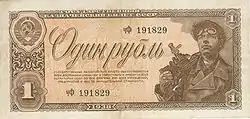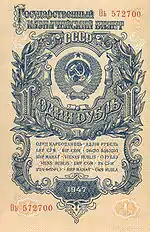Monetary reform in the Soviet Union, 1947
The monetary reform in the Soviet Union of 1947 (known as the "postwar reform") was carried out during December 16–19, 1947. It was the second Soviet monetary reform. At the same time the post-World War II rationing system was discontinued. The reform was a combination of denomination and confiscation, the latter depending on the amount exchanged and whether the monies were kept at sberkassa or not. State bonds were exchanged as well, under more favorable rules of denomination. The confiscative character was attributed to large amounts of counterfeit money produced by Nazi Germany, as well as to the desire to devalue the savings of the profiteers.[1]

1 rouble, 1938

1 rouble, 1947
References
- Денежные реформы в СССР 1922—1924 годов и 1947 года "Monetary reforms in the USSR of 1922-1924 and 1947" , "Финансовый менеджмент" magazine, 2001, no. 6 (retrieved January 20, 2014) (in Russian)
This article is issued from Wikipedia. The text is licensed under Creative Commons - Attribution - Sharealike. Additional terms may apply for the media files.